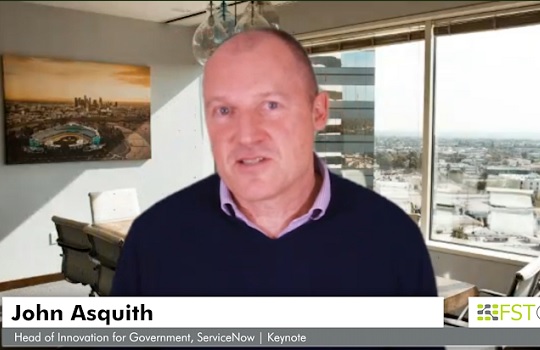
When confronted with the future unknowns of a socially transformative technology, it’s human nature to muse on the worst-case what ifs.
For the doomsayers among us, automation is a technology that often invites apocalyptic visions of mass robot armies replacing human workers and Skynet-inspired ‘rise of the machines’ type scenarios.
However, for John Asquith, head of innovation for government at ServiceNow, the future of automation is far cry from the dystopian images of “machines taking over from humans and taking away our jobs” – it is, in fact, a fundamentally human-centred technology.
If managed properly, automation – and indeed its intellectual ‘nerve centre’, AI – is far from a threat to “jobs and society”. In fact, intelligent automation is “a significant force for good”, Asquith says, and a technology that adds not only enormous value to service delivery capability within government but also to Australia’s economy.
“I realise there are deep suspicions about the impact of automation, especially as it relates to jobs and society. And those suspicions are not without merit,” Asquith said during his keynote address at the FST Government Queensland 2020 virtual conference.
However, he hastened to add, such suspicions are “based on futuristic notions of automation” that belie both its present capabilities and ignore the likely future limitations of the technology.
For Asquith, automation within the public sector is about a simple proposition: to empower human workforces to deliver better public services.
Successfully deployed, intelligent automation is about creating more meaningful work that not only boosts productivity, but ultimately enriches the human experience – both for employees and the end-consumers of their services.
This ambition aligns neatly with the future of work, one that ServiceNow research suggests will be “deeply human-centric and focused around the notion of an experience”, Asquith said.
“Experience is really the feeling that you’re left with following an interaction that you have as an individual at a specific time and specific place, and potentially using technology as part of an employee or customer journey.”
Intelligent automation technologies liberate humans “from the mundane, menial work, giving time back to focus on more meaningful work in our lives”.
They are about building experiences that motivate and engage workforces, Asquith said – experiences that, ultimately, deliver better outcomes for the communities they serve.
For an economy reeling from the Covid crisis, and facing potentially years of lingering recession, the ability to tangibly increase workforce productivity offers enormous resiliency and indeed growth potential for Australia’s service industries.
Citing a recent McKinsey study on automation’s potential within Australia, Asquith noted that accelerated adoption of automation technologies could boost annual productivity by up to 150 per cent, increase incomes by between $4,000 and $15,000 per Australian, and grow GDP by up to $600 billion by 2030.
“It sounds almost too good to be true,” he said. “So, we need to think about what sort of automation will actually enable this outcome.”
The key to unlocking this economic growth opportunity, Asquith stressed, lies in the workflow – that is, the digital workflow, which effectively overhauls “a lot of those old manual processes” that can stymie automation deployments.
From here, “tasks are then distributed to and completed by people who… can now be located anywhere, including working from home or in regional areas.”
Unlocking automation’s potential – the key is in the workflow
The success of any automation program is predicated on a longstanding, and perhaps inevitable, goal within most organisations today: digital transformation.
The digitisation of organisational workflows – transforming manual, often paper-based, processes into fully digital functions, in effect creating sequential and predictable data and rules to complete everyday organisational processes – is critical pre-condition for any automation deployment.
Yet, workflow digitisation alone can reap enormous benefits for organisations, even before an automation solution is deployed.
Citing ServiceNow studies, Asquith noted that employees in key operations functions can reap significant improvements in both end-customer and employee experiences when workflows are successful digitised.
“That’s because employees spend an average of 42 per cent of their time at work doing menial tasks which are boring and frustrating,” he said.
“Most people would rather be doing that more meaningful work that uses their human skills more effectively, leaving machines to do the menial work.”
Public agencies that can effectively digitise core workflows are well-equipped to deploy intelligent automation solutions at pace, scale, and even ad hoc in situations of immediate need.
Take Australia’s Home Affairs Department, which, perhaps with the exception of our health and welfare systems, became the key focal point of government during the Covid lockdowns. With the sudden closure of Australia’s borders and strict new conditions for departees and arrivals into the country, the Department was inundated with exemption requests for Australians needing to travel abroad during Covid.
Rather than relying on an existing email-based application process that requires a human response – “a system which could take weeks to respond to and, in many cases, would end up in a with a rejection simply because the right information had not been provided,” Asquith said – ServiceNow worked with Home Affairs to implement a new platform function that could automate application processes and approvals “within a matter of minutes, in some cases”.
Once digitised, these workflows could be “augmented by machines”, overlayed with an AI-backed platform that value-adds to and also extracts data insights from these processes to assist human workforces in higher-level decision making.
“This gives people access to the right information and advice to make the best decisions and to take the right actions”, he said.
In the case of Home Affairs’ automation platform, were an individual’s travel exemption application to be flagged during initial processing, the system would then move to extract relevant data to help human officials expedite and make the “right call” on travel approvals – a decision often vested in legal strictures and less quantifiable social impacts.
Machine learning and AI are, indeed, fundamentally tied to an automation system’s capability and ability to extract value-added insights from raw data. This ensures human workforces invest their valuable time only on the most high-value tasks at hand.
“They enable machines to learn from people over time, to start taking the more menial work off them, enabling [employees] to spend more time on the meaningful work that needs the skills of the person to do the right thing.”
According to Asquith, AI essentially sets a benchmark of “what good looks like”. It identifies and learns from the digital workflow data and ensures automation systems are able to reproduce results as required.
“Like any platform that uses AI, [automation] platforms need data to learn and that data needs to come from every stage of those workflows – even if the workflow extends over multiple areas of an organisation or even multiple organisations and their various systems of record.”
While he concedes that not every agency is able to “go all-in” with workflow digitisation, there is no doubt growing appreciation within government of the need to expedite workforce efficiency initiatives that can, ultimately, enrich front-end interactions.
Echoing points addressed by Queensland’s chief customer and digital officer, Chris Fechner, the event’s opening keynote presenter, Asquith said the Covid crisis has triggered a decisive push by agencies to drive rapid and collaborative digital transformation initiatives that work to enhance the citizen experience.
“One of the great outcomes we’ve seen is how government and industry can come together with a single purpose and get things done quickly and at low cost using this platform-based approach,” he said.
“What’s really exciting to me is that the consequences of being able to solve problems at such a rapid pace. It’s going to be transformational in its own right.”
Enriching the citizen experience
Ultimately, any automation program is predicated on how it benefits the end-user – for government, this is none other than the citizens they serve.
“Delivering a great service has to be a key goal for any government department,” Asquith said.
“I think most of us would agree that what great looks like should primarily be measured in terms of the customer’s perception and experience of the service. That’s what really counts.”
For Asquith, a motivated and engaged workforce is critical to delivering the best outcomes for communities they serve.
Put another way, a quality citizen experience is built upon an empowered human workforce.
Speaking at a recent ServiceNow-hosted hackathon, NSW Minister for Customer Service, Victor Dominello, sees the quality of service as a matter of time – that is, creating streamlined and efficient government services that give time back to citizens.
“Time is the final frontier,” he said. “With technology moving so fast, we’re getting more and more apps, and more and more digital clutter.”
“[Good service] is not just about giving money back to people in terms of refunds and rebates, but also about giving time back. The best way to make sure you only engage with government once; if we can get time back to people that will make for a far better customer experience.”
For Asquith, this is about eliminating repetitive and time-sapping tasks demanded of citizens each time they engage with government service.
“It’s about not asking the same questions every time you interact and having some understanding of what the most relevant services to me as an individual are.”
Yet, seamless service delivery is not necessary enough to engender trust and satisfaction in government services. This, ultimately, depends on governments breaking down their walls and offering a sense of transparency in their dealings with customers.
The increasing digitisation of front-end services, and commensurate reduction in call centre services, while often increasing the speed of interactions, has sacrificed a major source of citizen trust in government – the person-to-person interaction.
“Much of the work today being done around customer engagement has been aimed at eliminating the ability for people to talk to the back-office staff – those who actually do the work and know what’s going on,” Asquith said.
“But if that doesn’t enable an issue to be resolved quickly or doesn’t allow someone to know how things are tracking, it’s probably going to be a bad experience.”
Of course, while the idea of exposing an agency’s internal processes to the general public was, Asquith admits, once “unthinkable” and still “a little bit scary for most government organisations”, he believes it is it critical to engendering trust.
“It is about giving customers visibility into your organisation to see the status of their requests and how their issues are tracking without necessarily having to get on the phone to wait for someone to get back to them with an update.”
For citizens, Asquith stresses, these intuitive and proactive customer interactions are critical determinants of good governance.
Reiterating Chris Fechner’s point, government service quality has a very real impact on trust, confidence, and perceptions of government.
“Research consistently shows that key metrics like trust and customer satisfaction are improved [through governments’ customer experiences].
Creating seamless customer experiences, moreover, provides a tangible investment in your employees’ time and wellbeing.
By doing so, “your organisation becomes more efficient, you reduce reputational risk, and you end up with happier employees.” ◼
John Asquith is the Head of Innovation for government business workstreams at ServiceNow where he helps public sector organisations drive innovation and provides innovation opportunities into the ServiceNow product portfolio.
Connect with John directly on LinkedIn, or for more information on ServiceNow in Government, visit servicenow.com/gov





